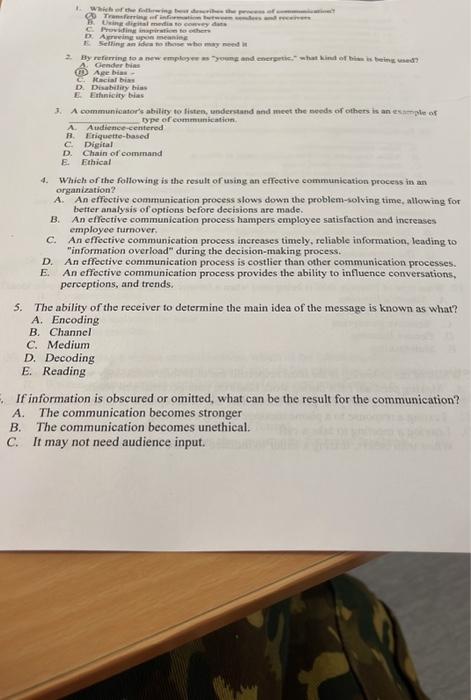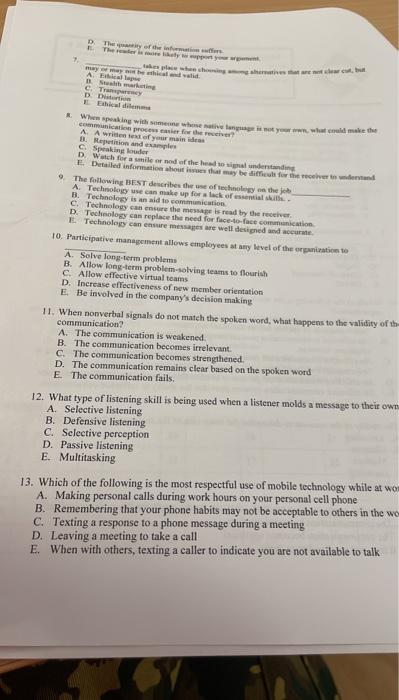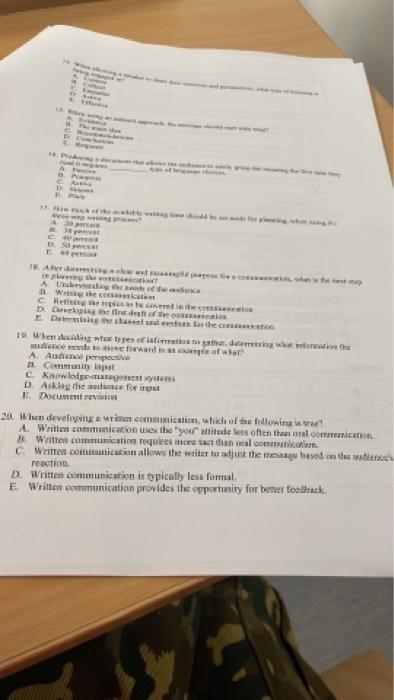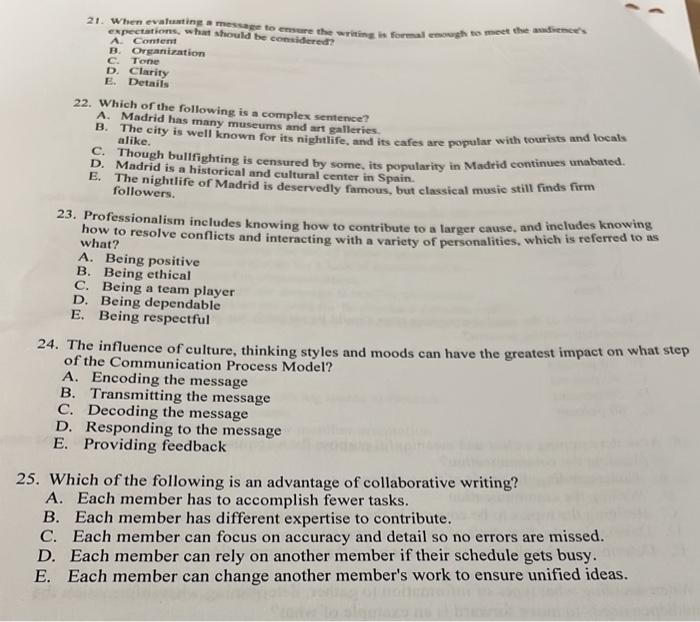4. Atadietice cectiferad fi. Ificelette-hasevi C. Dieital D. Chain of command E. Fthical 4. Whicl of the following is the result of using an effective communication process in an organization? A. An effective communication process slows down the problem-solving time, allowing for better analysis of options before decisions are made. B. An effective communication process hampers employee satisfaction and increases eraployee tarnover. C. An effective communication process increases timely, reliable information, leading to "information overload" during the decision-making process. D. An effective communication process is costhicr than other communication processes. E. An effective communication process provides the ability to influence conversations. perecptions, and trends. 5. The ability of the receiver to determine the main idea of the message is known as what? A. Encoding B. Channel C. Medium D. Decoding E. Reading If information is obscured or omitted, what can be the result for the communication? A. The communication becomes stronger B. The communication becomes unethical. C. If may not need audience input. Ci Tranopitamey If Disteirtion A. A wriden feat af yerur main idras C. Sippetieion anel traking Bouder 9. The folloning HEST dewacribes the use af tecthnolriny na the folb 13. Techinology is an aid to ecomamumicataon C. Thedinclogs anti ensure the mossufe is read try the receinct. 10. Participative management allows emplery ees at aty lhe of the qe mantration wo. A. Solve long-term problems B. Allow long-term problem-solving teams to flourish C. Allow effective virtual teams D. Increase effectiveness of new member orientation E. Be involved in the company's decision making 11. When nonverbal signals do not mateh the spolien word, what happens to the validity of th communication? A. The commanication is weakened B. The communication becomes irrelevant. C. The communication becomes strengthened. D. The communication remains clear based on the spoken word E. The communication fails. 12. What type of listening skill is being used when a listener molds a message to their owt A. Selective listening B. Defensive listening C. Selective perception D. Passive listening E. Multitasking 13. Which of the following is the most respectful use of mobile technology while at wo A. Making personal calls during work hours on your personal cell phone B. Remembering that your phone habits may not be acceptable to others in the wo C. Texting a response to a phone message during a meeting D. Leaving a meeting to take a call E. When with others, texting a caller to indicate you are not available to talk: is At Wrisite the scesequbather A. Amsiche perspoctive A. Connenaits ligenl C. Kicorkder-omatgomant xyazess D. Asklig fie aadience for itpest I. Docustatt Fzsiaife 20. When drvelosving a 4rimon ecomminicaticn, Whicha of the follogira ia true? S. Whitfent cumatumicating requles Hited tact thaf oral ooremerdadion. resticte 13. Wriftcet ovinumicarion is bpically less fommal. F. Writfin coqimumication provides the sppcritity for bewer fosdastk. 13. Cheaniontion C. Tome D. Clarity 22. Which of the following is an complex sicmtenice? A. Madrid has many mosseums and art gatleries. B. The city is well kmown for its mightlife. and its cafes are poypular with tourists and hocals. C. Though bullifghting is censured by somne. its popularity in Miadid continucs unabated. D. Nacirid is a historical and cultural center in spain. 23. Professionalism includes knowing how to contribute to a larger cause, and includes knowing how to resolve conflicts and interacting with a variety of personalities, which is referred to as what? A. Being positive B. Being ethical C. Being a team player D. Being dependable E. Being respectful 24. The influence of culture, thinking styles and moods can have the greatest impact on what step of the Communication Process Model? A. Encoding the message B. Transmitting the message C. Decoding the message D. Responding to the message E. Providing feedback 25. Which of the following is an advantage of collaborative writing? A. Each member has to accomplish fewer tasks. B. Each member has different expertise to contribute. C. Each member can focus on accuracy and detail so no errors are missed. D. Each member can rely on another member if their schedule gets busy. E. Each member can change another member's work to ensure unified ideas. 4. Atadietice cectiferad fi. Ificelette-hasevi C. Dieital D. Chain of command E. Fthical 4. Whicl of the following is the result of using an effective communication process in an organization? A. An effective communication process slows down the problem-solving time, allowing for better analysis of options before decisions are made. B. An effective communication process hampers employee satisfaction and increases eraployee tarnover. C. An effective communication process increases timely, reliable information, leading to "information overload" during the decision-making process. D. An effective communication process is costhicr than other communication processes. E. An effective communication process provides the ability to influence conversations. perecptions, and trends. 5. The ability of the receiver to determine the main idea of the message is known as what? A. Encoding B. Channel C. Medium D. Decoding E. Reading If information is obscured or omitted, what can be the result for the communication? A. The communication becomes stronger B. The communication becomes unethical. C. If may not need audience input. Ci Tranopitamey If Disteirtion A. A wriden feat af yerur main idras C. Sippetieion anel traking Bouder 9. The folloning HEST dewacribes the use af tecthnolriny na the folb 13. Techinology is an aid to ecomamumicataon C. Thedinclogs anti ensure the mossufe is read try the receinct. 10. Participative management allows emplery ees at aty lhe of the qe mantration wo. A. Solve long-term problems B. Allow long-term problem-solving teams to flourish C. Allow effective virtual teams D. Increase effectiveness of new member orientation E. Be involved in the company's decision making 11. When nonverbal signals do not mateh the spolien word, what happens to the validity of th communication? A. The commanication is weakened B. The communication becomes irrelevant. C. The communication becomes strengthened. D. The communication remains clear based on the spoken word E. The communication fails. 12. What type of listening skill is being used when a listener molds a message to their owt A. Selective listening B. Defensive listening C. Selective perception D. Passive listening E. Multitasking 13. Which of the following is the most respectful use of mobile technology while at wo A. Making personal calls during work hours on your personal cell phone B. Remembering that your phone habits may not be acceptable to others in the wo C. Texting a response to a phone message during a meeting D. Leaving a meeting to take a call E. When with others, texting a caller to indicate you are not available to talk: is At Wrisite the scesequbather A. Amsiche perspoctive A. Connenaits ligenl C. Kicorkder-omatgomant xyazess D. Asklig fie aadience for itpest I. Docustatt Fzsiaife 20. When drvelosving a 4rimon ecomminicaticn, Whicha of the follogira ia true? S. Whitfent cumatumicating requles Hited tact thaf oral ooremerdadion. resticte 13. Wriftcet ovinumicarion is bpically less fommal. F. Writfin coqimumication provides the sppcritity for bewer fosdastk. 13. Cheaniontion C. Tome D. Clarity 22. Which of the following is an complex sicmtenice? A. Madrid has many mosseums and art gatleries. B. The city is well kmown for its mightlife. and its cafes are poypular with tourists and hocals. C. Though bullifghting is censured by somne. its popularity in Miadid continucs unabated. D. Nacirid is a historical and cultural center in spain. 23. Professionalism includes knowing how to contribute to a larger cause, and includes knowing how to resolve conflicts and interacting with a variety of personalities, which is referred to as what? A. Being positive B. Being ethical C. Being a team player D. Being dependable E. Being respectful 24. The influence of culture, thinking styles and moods can have the greatest impact on what step of the Communication Process Model? A. Encoding the message B. Transmitting the message C. Decoding the message D. Responding to the message E. Providing feedback 25. Which of the following is an advantage of collaborative writing? A. Each member has to accomplish fewer tasks. B. Each member has different expertise to contribute. C. Each member can focus on accuracy and detail so no errors are missed. D. Each member can rely on another member if their schedule gets busy. E. Each member can change another member's work to ensure unified ideas










